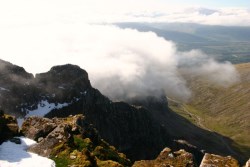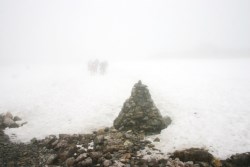
Join us on
Please visit the Sitemap to see the full range of information on this site
MountainWalk.co.uk is produced by Trish Haill Associates Copyright
Have you climbed Ben Nevis, Snowdon or Scafell Pike? Or taken part in the Three Peaks Challenge? Or have a special walk you'd like to share? We'd love to here from you! Join us on Facebook or Send us an email.
Don't get Lost - A Simple Guide to basic Navigational Skills
Using a Map and Compass
For the inexperienced or novice walker there is only one recommended walk up Ben Nevis, two popular routes up Scafell Pike and six tracks up Snowdon. All these paths are well trodden, and where the way is not quite so clear (across scree or boulders) there are cairns which mark the way. Hundreds of people walk these paths each day during the late spring/summer months. So what could possibly go wrong?
In 2011 there were 411 calls for help from hill walkers and climbers lost on Mount Snowdon in Wales. Rescue teams, manned by volunteers spend hundreds of man hours locating people who have become lost.
In 2011 there were 411 calls for help from hill walkers and climbers lost on Mount Snowdon in Wales. Rescue teams, manned by volunteers spend hundreds of man hours locating people who have become lost.

Sometimes these walkers have ventured onto very dangerous paths and had become crag fast - i.e. They were too scared to move forward or back.
Mountain weather is notoriously unpredictable, and what at sea level will just be an inconvenient cloud passing over the sun, at higher points will be thick fog which can suddenly envelope the unsuspecting walker. And if youíre at a critical point in your walk where youíve got a junction of two or more paths to choose from, the sudden loss of any points of reference could cause you to make an error of judgement and take the wrong route which could mean you end up walking many more miles than expected.
Unpredictable Weather
Mountain weather is notoriously unpredictable, and what at sea level will just be an inconvenient cloud passing over the sun, at higher points will be thick fog which can suddenly envelope the unsuspecting walker. And if youíre at a critical point in your walk where youíve got a junction of two or more paths to choose from, the sudden loss of any points of reference could cause you to make an error of judgement and take the wrong route which could mean you end up walking many more miles than expected.
This picture shows a sunny day in the valley, but dense cloud moving over the mountain side in the Lake District
Far worse, if you are walking on scree or boulders, and any discernable path suddenly vanishes underfoot, you may find yourself walking into danger on an unexpectedly steep slope, or worse, close to a crevasse.

The path to the summit of Ben Nevis disappears under snow and mist
Bad enough if you are alone or with other adults, but you are walking with children the situation could be very frightening. What started out as a pleasant summer stroll in the sun could turn into a nightmare. Mountain rescue services are unfortunately well used to rescuing people whoíve got themselves lost, and not knowing what you are walking into could mean that you end up injured and need the assistance of emergency services too.
This disturbing picture is not painted to deter you from climbing one of the highest peaks in the UK, but just to make you consider how important it is to know where you are at all times on the mountains, and how to keep to the path youíve chosen so you can get down again safely and in one piece. Read how one family got into problems with fog on Scafell Pike.
This disturbing picture is not painted to deter you from climbing one of the highest peaks in the UK, but just to make you consider how important it is to know where you are at all times on the mountains, and how to keep to the path youíve chosen so you can get down again safely and in one piece. Read how one family got into problems with fog on Scafell Pike.
Take a Map and Compass with you
A map and simple compass will probably only set you back about ten pounds, but could be a life saver. However, just having these with you will not help when the fog descends. You have to know a few simple steps on how to use them, and keep tabs on your progress as you go along. Map reading can be fun - and you will get to know the names of the places you are passing on your route.
Grid Reference Notice Trial on Mount Snowdon
The Mountain Rescue Teams in Snowdonia have come up with a new idea of putting grid reference plaques up on gates and stiles along all of the paths going up Snowdon. You will need a map to locate your position, but the Snowdonia National Park Wardens hope it means people will be able to find their way without calling out the emergency services.
To make best use of the grid reference information it's best to practice your map reading skills before attempting to climb Mount Snowdon.
How to use a Map and Compass
Itís a good idea to practice with a map and compass at home to get the idea of how to use it. The first thing you need to do is to orient the map - this means holding it so North on the map is matching the North indicated on your compass . Take out your map at the start of your walk and locate exactly where you are You can do this by looking at the land marks, and laying your map out so that it matches the landscape. On your map there will be a declination diagram in the margin - this shows how many degrees to the left or right you need to adjust for the difference between north marked on your map, and true magnetic north. You should now link up the direction of travel line on the compass baseplate with the zero mark on the dial. Making sure the direction of travel points to north on the map rotate both map and compass until the magnetic needle points to the number of degrees that the declination diagram shows. If the diagram shows magnetic north as 5 degrees to the left, the compass needle should point 5 degrees left of zero. Once this is done, north on your compass is the same as north on your map.
It is actually preferrable to carry two compasses with you. Firstly, one compass might get lost, or damaged. Secondly compasses might misfunction. The polarity of a compass can be affected if it comes into contact with anything magnetic. This includes a mobile phone, GPS, keys or even the zip on your jacket. Instead of pointing North, the compass can be pointing south. Compasses should not be kept near to any electronic gadgets you carry. When you are using a compass try to keep it well away from your body. Take a note of the contours on the map, and if the route you are following seems steeper than you expected, check your second compass, or your GPS. If you are at all unsure, retrace your steps.
A handheld GPS is the modern way to help you get you to where you want to go and back again, and some smartphones with GPS are able to download walking maps. However, even with technical help it's still advisable to take a map and compass with you. One benefit of a GPS is that if you or any of your companions have an accident when hiking your GPS will allow you to tell the rescue services exactly where to find you, and possibly save a life but you must remember that a GPS it is not 100% accurate, and could be several metres adrift. Just like Sat Navs used on the road can direct drivers down a one way street, you still have to use common sense with a GPS - it wouldn't be clever to follow it blindly off the edge of a cliff!
Tips to be safe on the Mountain
To be completely safe when climbing in the mountains follow these simple steps:
Itís a good idea to practice with a map and compass at home to get the idea of how to use it. The first thing you need to do is to orient the map - this means holding it so North on the map is matching the North indicated on your compass . Take out your map at the start of your walk and locate exactly where you are You can do this by looking at the land marks, and laying your map out so that it matches the landscape. On your map there will be a declination diagram in the margin - this shows how many degrees to the left or right you need to adjust for the difference between north marked on your map, and true magnetic north. You should now link up the direction of travel line on the compass baseplate with the zero mark on the dial. Making sure the direction of travel points to north on the map rotate both map and compass until the magnetic needle points to the number of degrees that the declination diagram shows. If the diagram shows magnetic north as 5 degrees to the left, the compass needle should point 5 degrees left of zero. Once this is done, north on your compass is the same as north on your map.
It is actually preferrable to carry two compasses with you. Firstly, one compass might get lost, or damaged. Secondly compasses might misfunction. The polarity of a compass can be affected if it comes into contact with anything magnetic. This includes a mobile phone, GPS, keys or even the zip on your jacket. Instead of pointing North, the compass can be pointing south. Compasses should not be kept near to any electronic gadgets you carry. When you are using a compass try to keep it well away from your body. Take a note of the contours on the map, and if the route you are following seems steeper than you expected, check your second compass, or your GPS. If you are at all unsure, retrace your steps.
A handheld GPS is the modern way to help you get you to where you want to go and back again, and some smartphones with GPS are able to download walking maps. However, even with technical help it's still advisable to take a map and compass with you. One benefit of a GPS is that if you or any of your companions have an accident when hiking your GPS will allow you to tell the rescue services exactly where to find you, and possibly save a life but you must remember that a GPS it is not 100% accurate, and could be several metres adrift. Just like Sat Navs used on the road can direct drivers down a one way street, you still have to use common sense with a GPS - it wouldn't be clever to follow it blindly off the edge of a cliff!
Tips to be safe on the Mountain
To be completely safe when climbing in the mountains follow these simple steps:
| 1 | Check the mountain weather forecast before you leave - the Met Office have forecasts for all the mountain areas. Be sensible - if the visibility is very poor itís probably not the best day for your walk. |
| 2 | Make sure you have a map and compass with you, that you know how to use these, and that you orient your map at the start of the walk and check your position regularly. |
| 3 | Whether or not your phone has GPS, make sure your battery, and those of any companions walking with you is fully charged in case you need to call for help. A variety of networks would be useful as the signal cannot always be guaranteed. |
| 4 | Carry some emergency equipment with you - a torch in case you are longer on the mountains than you expected (those equipped to flash as a beacon in an emergency are recommended), and a foil blanket in case you fall and need to keep warm until help arrives. These are very cheap and small to fit in your rucksack. |
Ben Nevis, Scafell Pike and Snowdon, and other major walks in the UK are probably the safest as they are well marked and a lot of people walk them, but people still manage to get lost. If you want to walk up other mountains being equipped with a map and compass and the basic knowledge of how to use them is not optional, but essential.
You might also be interested in:
Equipment
Hiking Equipment Reviews
GPS and Smartphones
Buying Maps and Compasses
Equipment
Hiking Equipment Reviews
GPS and Smartphones
Buying Maps and Compasses
